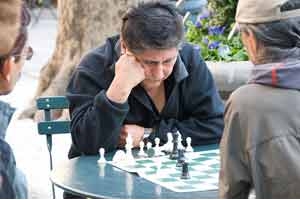How to Increase Your Creativity
6 tips to tap your inner wellspring of ideas
 "Clearly nothing catching that day!" courtesy of netdiva
"Clearly nothing catching that day!" courtesy of netdiva"Problems cannot be solved by the same level of thinking that created them." ~ Albert Einstein
They were starving in the castle. The enemy had surrounded the castle and blocked all supplies of food from entering, hoping to starve them out. They had a problem, but they solved it. More of that in a moment.
To be creative, you need to think outside the box. Well, yes, but that well-worn metaphorical cliché in itself has been over-used to the point of creative redundancy. True creativity is fresh, new, and unexpected. And it can be shocking.
And here's a warning: When you exercise true creativity, others may, at first, suspect you have gone crazy.
Most of the time, most people think in 'straight lines'; so any nonlinear thought seems absurd to those who only have sequential rationality at their disposal. When you have a creative insight, don't necessarily expect others to get it straight off. Creativity lends perception beyond the immediate and most people can't see beyond the immediate.
Here's a case in point:
When crazy is sane
Back in the days of castles, knights, sieges, and that kind of thing, an army had surrounded the impregnable castle Hochosterwitz (in present day Austria) and had it under siege. The fortress was well defended and the siege lasted for months as the attacking army hoped to starve the occupants out of their stronghold.
But as time passed, the siege army was getting restless and the commander had other pressing things to do. What they didn't know was that the defenders inside the castle were down to their last ox and last barrel of barley.
What would you have done if you were the defending commander? Extreme situations can (if we don't panic) call forth wonderful acts of creativity. As a matter of fact, he did something that must have made everyone around him despair of his sanity. He had the one remaining ox slaughtered, had its guts filled with the last remaining barley, and had the ox thrown over the side of the castle. Now they had no food at all!
But on seeing what was clearly a symbolic message that the castle occupants had more than enough food, the besieging army became discouraged and almost immediately pulled up their tent stakes and left.
Doing the opposite of what was expected saved the day for the occupants of the stronghold (1). To me, the commander of the fortress showed genuine artistry because creativity can manifest anywhere.
Creativity: not just for the 'creative'
People often assume 'creativity' is the preserve of artistic types and if they don't paint or sculpt or write or play music, then creativity has passed them by. Not so. Creativity can infuse and determine everything or anything you do. Even conversation is a creative act. When people are amusing and interesting, they may be using just as much of their creative power as a painter producing a masterpiece. Your creativity might manifest in business, interpersonal relations, or sport. Creativity spans all of life's endeavours.
You might want to find reliable ways to get into the creative zone for writing, painting, business ideas, or even before you go out to a social event. Whatever your reasons to boost creativity, these tips will help.
1) Increase creativity by getting silly
When the world gets too familiar, your mind goes onto automatic pilot - the opposite of creative. Playfulness is all about creativity, so get 'silly' and don't dismiss anything during the creative phase. If you fear having your idea 'shot down in flames', you won't feel playful; you'll feel tense - and creativity will dry up quicker than saliva in a virgin's mouth on his wedding night. The key here is to discount nothing.
Whether you're finding inspiration in a group or going it alone, purposefully make some 'ridiculous' suggestions. Don't dismiss anything out of hand. How many solutions have come about from jokes and 'silly suggestions'? Embrace your inner idiot because sometimes there is wisdom in 'idiocy'. In fact, purposefully imagine the exact opposite of what you 'should' do. Have a brainstorming session in which the suggestion for the most counterproductive idea wins. Maybe that's what was going on in Castle Hochosterwitz all those years ago.
2) Use the power of your unconscious mind
It's a powerhouse in there, it really is. There is more inside your mind than you could possibly know. Sometimes we need to stand aside and let the part of us that can be creative have free rein.
A hypnotist (or hypnotherapist) will aim to distract the conscious mind so that the unconscious mind can do what it's good at (2). People often assume they need to 'empty their mind' in order to be creative, but research (3) has discovered that when people are given an unrelated task to do after being asked to create a new idea, the ones who give their unconscious minds a chance to work (because they are focusing on something else) show remarkably more creativity than people who just focus on trying to be creative. Whilst your conscious mind is busy, your unconscious mind has a chance to solve and create.
So once you have done some conscious pondering, forget about the problem you're working on (or the idea you're trying to have) and go do something else entirely. Play with the kids, go for a walk, bounce on a trampoline, or joke with a neighbour. The point is, once you've done the prep work, your mind works on finding creative solutions when you're not consciously focusing.
3) Prime your mind to be more creative
Your environment primes you more than you know. For example, a background smell of cleaning fluid reliably makes people cleaner and tidier (4). And whatever your views on 'modern art', researchers found that the subliminal effect of having 'creative paintings' on the walls is to make people more creative - whether they profess an interest or liking for art or not and whether or not they consciously notice those unconventional paintings (5). So a bit of Rothko or Pollock may go a long way.
4) Increase creativity by using stereotypes
Here's another way to prime your mind. Research has found that being exposed to a verbal or visual pattern can prime our behaviour. In one study (6), it was found that young people exposed to words associated with age and frailty walked more slowly afterwards.
Individuals asked to imagine people who look intelligent (like professors) went on to score better in IQ tests. But when they visualized 'soccer thugs', they scored much lower (7). How can we use this for our creative purposes?
Viewing pictures of 'creative types' such as people who dress unconventionally or who look like artists, musicians, or poets also seems to inspire increased creativity in the person exposed to such images (6). (Although looking at an image of a 'one-off genius' such as Picasso can make us less creative, because it's easier to join a group than feel connected to a one-off.) So when priming yourself to be creative, close your eyes for a minute and just visualize lots of different imaginary or real people who look creative to you.
5) Increase creativity by going green
It's well established that having a view of nature from a hospital window promotes more rapid healing (8) and that natural greenery seems to lower anti-social, even violent, behaviour (9). But some Japanese psychologists also found that, in study after study, people displayed more creativity in office environments if potted plants were in view, as opposed to, say, just PC monitors. It may be that from an evolutionary perspective, we view a green environment as a sign that abundant food sources are probably close by. With less need to fight for scarce food, we can forget about that for a while and have more opportunity to relax, giving us the spare capacity to be creative.
In another study carried out over eight months, it was found that simply adding plants and flowers to an office increased male employees' creative ideas by 15% and also encouraged more flexible creative solutions from their female colleagues (10). In yet more research, it's been found that children behave more creatively when they play in nature. So either get yourself a great natural view or invest in some potted plants and flowers.
Creativity is all about making connections. The next tip gets you doing just that.
6) Increase creativity by making connections
"Creativity is the ability to see relationships where none exist." ~ Thomas Disch
When we take one pattern in life and productively apply it to another, we are creative. Velcro, road safety 'cats eyes', and the sowing machine were all invented because someone observed a pattern and applied it somewhere else. And let's not forget the famous Archimedes, who discovered how to determine the volume of an irregularly-shaped object by noticing how his body displaced water in the bath (why didn't I think of that!).
Do the 'it's like exercise'. For example:
- Getting more customers is like being a street artist and getting people to stop and listen.
- Becoming more confident is like a flower opening up to the sunlight.
- This difficult conversation I'm about to have is like splashing ice cold water in my face when I wake up in the morning - bracing but necessary.
- Writing this book is like going on an exciting journey.
Take a situation and imagine what else it could be likened to - the more obscure or weird, the better. Doing this may well help generate unexpected solutions and perspectives. Really think about why something is like something else.
If we live timidly, always prefer routine to change, balk at new ideas and cling to the past, we exist. But to live fully, we need to create. As Carl Jung said, "If you feel you have nothing at all to create, then perhaps you can create yourself."
References
- This historical account is recounted in the wonderful book Change: Principles of Problem Formation and Resolution by Paul Watzlawick, John Weakland, and Richard Fisch.
- When hypnotizing, we might use 'confusional' language to distract the conscious mind whilst we embed suggestions. Other ways to give something of interest to the conscious mind so that it 'gets out of the way' may be storytelling or even asking a person to count backwards in their head from one hundred to one.
- Dijksterhuis, A. and Meurs, T. (2006) "Where Creativity Resides: The Generative Power of Unconscious Thought." Consciousness and Cognition, 15, pages 135-46.
- Holland, R.W., Hendriks, M., and Aarts, H. (2006) "Smells Like Clean Spirit: Non-Conscious Effects of Scent on Cognition and Behaviour." Psychological Science, 16 (9), pages 689-93.
- Forster, J., Friedman, R., Butterbach, E.M., and Sassenbach, K. (2005) "Automatic Effects of Deviancy Cues on Creative Cognition." European Journal of Social Psychology, 35, pages 345-59.
- Bargh, JA, Chen, M, and Burrows, L. (1996) "Automaticity of Social Behavior: Direct Effects of Trait Construct and Stereotype-Activation on Action." Journal of Personal and Social Psychology. 1996 Aug;71(2):230-44.
- Two Dutch researchers carried out a study asking groups of students fairly difficult questions from the game Trivial Pursuit. The groups were split into two; half were asked to spend five minutes before the test thinking about what it means to be a college professor - e.g. smart, glasses, air of academia, etc. - and half were asked to think about what it means to be a soccer hooligan - e.g. rough, loud, trouble maker, drinking, arrests, etc. They wrote down all the associations they could think of.
The 'hooligan' group got an average score of 42.6 percent of the questions right. The 'professor' group's average was 55.6 percent.
The test was repeated several times with different groups, with allowances made for IQ and even how familiar people were with Trivial Pursuit. The results came out the same. Thinking about stereotypical smart people makes you smarter! Thinking about dumb people and words you associate with stupidity makes you dumber! - Ulrich, R.S. (1984). "View Through a Window May Influence Recovery From Surgery." Science, (224), pages: 420-1.
- Kuo, F.E. and Sullivan, W.C. (2001) "Environment and Crime in the Inner City: Does Vegetation Reduce Crime?" Environment and Behavior, 33, pages 343-65.
- This research was conducted by Robert Ulrich from Texas A and M University.






